Why and how to create performance standards in an organization (plus examples)
Last updated on: June 20, 2023
Every job has its own description of what needs to be done when working in that position. In addition, there are performance standards — they show how to perform position-related tasks to do the job well.
So, when evaluating your employees, you’ll compare their performance with predetermined standards – performance standards. Be sure that these standards are founded on specific positions, not individuals.
This article will guide you through all the details about performance standards, such as:
- the purpose of performance standards,
- the three levels of performance,
- what to consider when establishing performance standards,
- how to create a performance standard, and
- examples of performance standards.
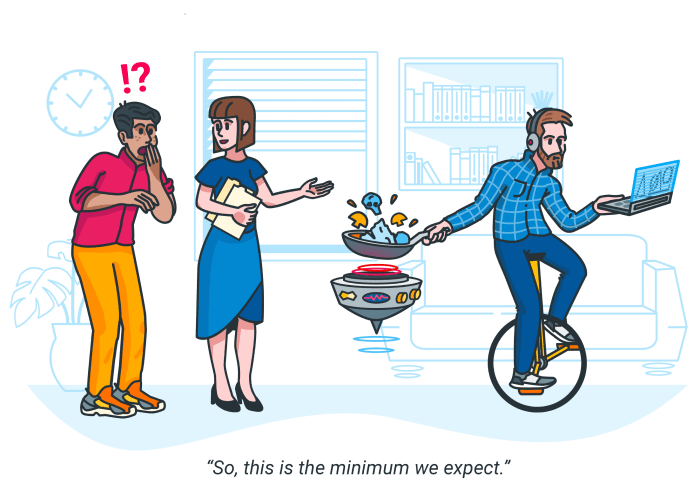
Table of Contents
What is the purpose of performance standards?
Before we explore the purpose of performance standards, let’s have a step back and define performance management.
Performance management is the communication process between employers and employees.
This process also involves giving feedback to the workers. To know how to conduct their job with success, employees first need to see the performance standards for that position.
The goal of performance standards is to ensure that both employers and employees are on the same page regarding job expectations. That’s why managers need to provide their new employees with the performance standards during the first month of employment.
Performance standards also equip employees with specific performance outlooks for every skill.
Furthermore, performance standards foster communication between managers/employers and workers.
When it comes to evaluations, managers use performance standards as a guideline. Then, they compare employee performance with this fixed pattern. This way, there’s an equal evaluation for all employees in the same position.
Regarding performance standards, all workers are equal and should be treated the same way. According to the U.S. Equal Employment Opportunity Commission, both employees with disabilities and without it, “must meet the same production standards, whether quantitative or qualitative.”
Performance standards should be:
- specific,
- achievable,
- easy to understand,
- relevant to the position, and
- easy to measure.
Once an employer or a manager has evaluated the employees, their expectations can be:
- Met – if an employee showed adequate performance,
- Exceeded – if the performance is beyond well, and
- Not met – if the performance is below the performance standards levels.
So, in the case of insufficient performance, the employer or supervisor has to issue a Performance Improvement Plan (PIP). The purpose of this document is to help an employee improve his/her performance.
The PIP happens in the last phase of the performance management cycle – the review phase. In brief, this is the phase when managers track employee performance by conducting evaluations. We mentioned before that this cycle starts with setting performance standards.
Now, performance management includes three levels within the organization.
What are the three levels of performance?
Performance management can be focused on the entire organization or its departments. Besides, it can emphasize the performance of individual employees. Thus, there can be three levels of performance management:
- strategic performance management,
- operational performance management, and
- individual performance management.
Strategic performance management
The purpose of this level is to achieve overall organizational goals. Thus, this is the highest rank of using performance management standards in the organization.
To accomplish these objectives, company management strives to answer these questions:
- Does this company have a strategy for achieving its goals? If so, does the company implement this strategy?
- Is the organization bringing the expected results?
Operational performance management
The intention here is to get operational goals. This level focuses on processes within the organization, such as projects or activities. Thus, the intent is to find out if these specific projects/activities are working.
To reach these objectives, company management has to answer the following questions:
- Is each department or project fulfilling its targets?
- Are operational activities aligned with the organizational strategy? If so, how do these activities promote organizational strategy?
- Are projects or activities efficient enough or should they be changed?
Individual performance management
Finally, this level emphasizes the performance of each employee in the company. This process begins with setting work goals and standards, reviewing employee performance, and enhancing learning skills of each employee.
To carry out these goals, company management needs to get answers to these questions:
- How are individuals working?
- How can they boost their performance?
When reviewing employee’s work, performance standards are your point of reference. These standards are vital because they analyze diverse areas of performance. Let’s take a look at how to properly determine the performance standards and what to consider when doing so.
What to consider when establishing performance standards?
To ensure that standards are suitable for a particular position, here are four points you should consider:
- Standards need to be motivational.
- Standards should not be too easy nor too difficult to achieve.
- Let your employees know that you’re analyzing their performance.
- Establish a trial period.
Standards need to be motivational
Having motivational performance standards will make workers more inspired to do their job better. Besides, if they’re able to see their progress within a project, this will also be their driving force. Thus, they’ll be more likely to achieve exceptional levels of performance.
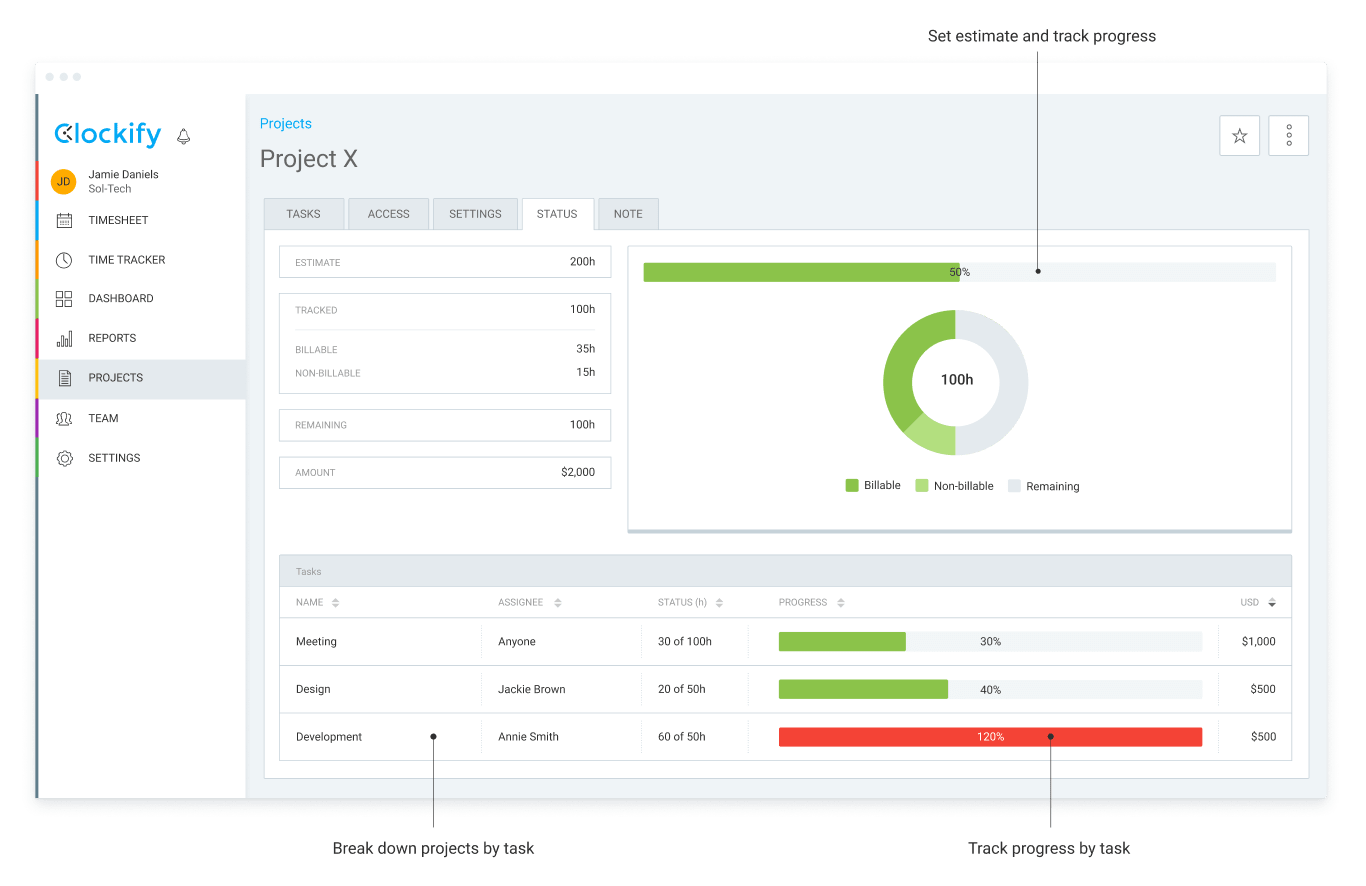
As a leader, you can encourage your workers to track their working hours. Employee time tracking is beneficial to your employees, too, because they’ll be able to review their project progress. So, they’ll discover what part of the project they have finished, and what still needs to be done. Moreover, workers will continue with completing their tasks the best they can.
💡In case you need to monitor who was working on what tasks and for how long, you can use Clockify as a free employee attendance tracker.
Standards should not be too easy nor too difficult to achieve
If performance standards contain tasks that are too simple, they’ll be too easy to achieve. So, employees won’t be motivated because they won’t be challenged to finish a particular task.
On the other hand, performance standards should not be too complicated. If they are, workers will struggle to complete almost every assignment. Therefore, their performance levels may decline.
But, how do you find the right balance between these two? Be sure that performance standards should be daring enough. That way, workers will have to search for an ideal strategy to finish their tasks. Whenever they succeed, employees will feel that they’re working towards accomplishing their goals. Thus, they will be more enthusiastic about their job.
Let your employees know that you’re analyzing their performance
In case there’s a new employee, a supervisor has to inform an employee about performance standards that regulate his/her position. Likewise, all the other workers need to know that the company is evaluating their performance.
So, a manager has to be transparent about performance standards. Throughout the year, leaders should remind employees about these measures. If workers need an explanation for some part of the standard, managers should provide them with clarification.
Establish a trial period
As a manager, you don’t have to set performance standards by yourself. Let the HR staff help you write down these measures.
Aside from the HR team, you can also include your team members as well. This step is crucial because your employees may have some concerns about the current measures. If so, adjust these parts of the performance standard.
Then, you should start testing these new measures by setting a trial period, which can last from six to eight weeks. This way, you’ll get straightforward feedback from your employees. Once the trial period is complete, ask your workers if these standards were suitable for them. Again, if there are any current issues, be sure to slightly modify the measures.
Including your employees in creating performance standards will boost trust between you and them. Moreover, when workers take part in such a process, they’ll feel like valued members of the company. Plus, this will increase employee productivity, too.
We covered some general considerations for creating a performance standard. Now, let’s take a look at some practical rules for writing these measures.
How do you create a performance standard?
Let’s say that you and your team want to create a new performance standard for several positions within the team. If you’re still unsure how to start and what requirements you should cover, here are a few simple steps to ease this process.
Focus on the position, not individual
Remember that measures you’re writing should be about a position, not an individual. So, if there are four employees in the same position, the performance standards for them should be the same.
If more than one employee performs the same task, standards should be identical for conducting this particular task. This rule applies even if these workers are in diverse positions within the company.
Decide what tasks should be included in the standard
You shouldn’t incorporate every assignment into the performance measures. Determine what tasks are the most important for each position. Then, write performance standards only for these tasks.
By choosing the most significant ones, you’ll have a brief standard.
Choose parameters that make a performance successful
To perform a job successfully, employees must meet particular criteria. Here are some indicators of an effective performance:
- precision,
- conducting job duties on time,
- customer satisfaction,
- showing signs of leadership,
- being productive,
- showing initiative,
- showing creativity, and
- quality of work.
But, there’s more. An employee with the beyond-expectations performance will present qualities such as:
- professionalism,
- constantly following professional protocols,
- their performance is constantly improving,
- always performing their best,
- being meticulous,
- having visionary ideas and solutions, and
- expressing their own opinions.
Think about the error rates
Performance standards always have to be clear and specific, so employees could easily work in line with these standards. If you want to evaluate how individuals or teams are performing, you can also do this with Key Performance Indicators (KPI).
Generally speaking, KPI can help you find out how your company is performing and if it’s going towards achieving its goals. As you can imagine, all workers need to align their performance with the company’s objectives. Plus, they need to do their job following performance standards.
But, what happens when an employee presents inferior performance, below the acceptable standards? The above-mentioned Performance Improvement Plan is one of the solutions.
Before starting with this plan, first, you’ll need to decide how many errors are too many. For example, an employee can have a performance below the suitable levels twice. But, if this happens again, you may give him/her an “Improvement needed” rating.
You may have a different plan for setting error rates. Whatever you choose, just stick to that plan.
Create standards for solid performance first, then the others
When creating performance standards, begin with positive aspects first. So, you can start by writing down the qualities of a solid performance. Then, continue with the qualities of the above-expected performance.
Once you have these two categories, focus on indicators that are below the solid levels. You can use phrases like this:
- An employee proves a solid performance when…
- An employee proves an above-expected performance when…
- An employee proves a below-appropriate performance when…
The in-depth explanation for each sentence will depend on the employee position.
If you’re eager to see how these performance standards look like in practice, keep reading.
What are the examples of performance standards?
Performance standards can vary depending on the position and job description. The only thing that’s common to all performance standards is that they demonstrate how one’s job should be done well.
Performance standards for teachers
Let’s find out what performance standards would look like for teachers.
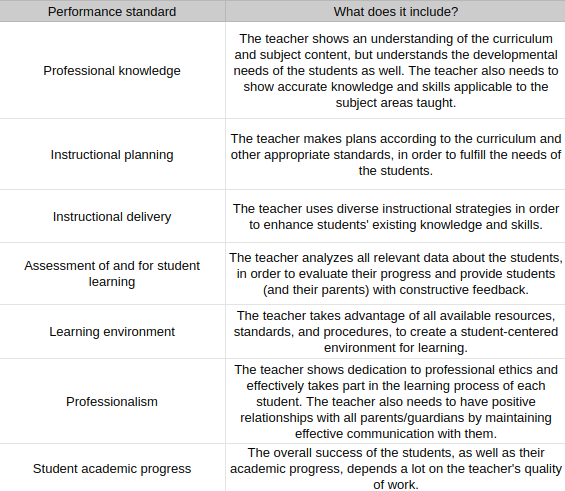
As you can see from the table above, each measure has an in-depth explanation. So, every new teacher will have to review these standards in the first month of employment.
The purpose of these measures is to find the proper ways of presenting the curriculum to the students. To do so, teachers can use all available resources, so that the students can comprehend everything with ease. Besides, teachers have to maintain positive relationships with students’ parents or guardians.
Performance standards for administrative assistants
Here’s an example of performance standards for administrative assistants.
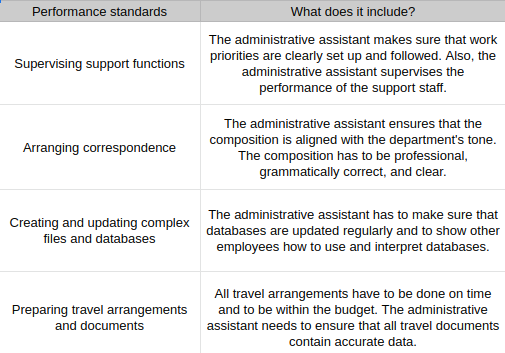
When it comes to administrative assistants, their performance standards include supervising support functions, arranging correspondence, and ensuring that all files and databases are well organized and updated. In addition, administrative assistants need to make sure that travel arrangements are within the budget and that travel documents hold accurate information.
Performance standards for technical support providers
Now, let’s take a look at an example of performance standards for technical support providers.
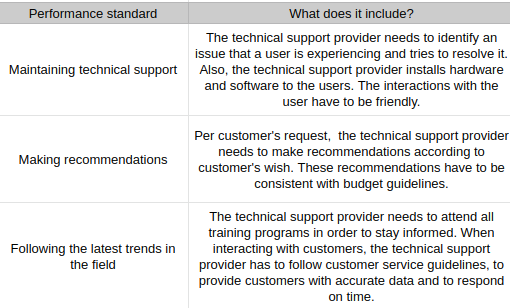
As you can see from this table, performance standards for this occupation are maintaining technical support, making recommendations to the users, and staying updated with the latest trends in this field. The purpose of these measures is to ensure that technical support providers offer only accurate information to the users. Besides, technical support providers need to act friendly and to be as responsive as possible.
Performance standards linked with the company’s goals
Now, according to Lenny Pollack, a Professor of Practice at the Penn State University, you can also link performance standards with responsibilities and company goals.
So, for instance, one of the company’s objectives is to improve customer service. Let’s take a hotel as an example of this company. The first person you see when you enter is a receptionist. Naturally, a receptionist’s responsibility is to greet visitors.
But, how the receptionist will greet visitors is what matters. To enhance customer service, the receptionist has to be friendly and welcome visitors with a smile. Plus, the receptionist needs to provide them with as much information about the hotel as they need. Moreover, if visitors have any concerns, the receptionist has to find a way to solve these issues.
By following these performance standards, the receptionist will present excellent performance and achieve the company’s goal.
Conclusion
For employees, performance standards are a guideline on how to properly do their job. For managers, these measures are a comparison point when they review employee performance.
Performance standards need to be specific, easy to understand, and achievable. This way, employees will be motivated to align their performance with the set measures.
Depending on how employees have performed over the last period, leaders can mark their work as a solid, an above-expected, or a below-appropriate performance. It’s up to the manager to decide what’s the limit when it comes to unsatisfactory performance.
This article underlined the most significant aspects of performance standards. Also, we covered several examples of these measures. Whenever you struggle to create performance standards, you can go through it one more time.





